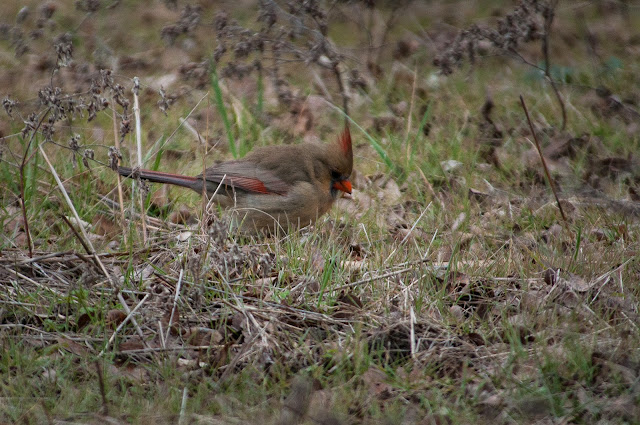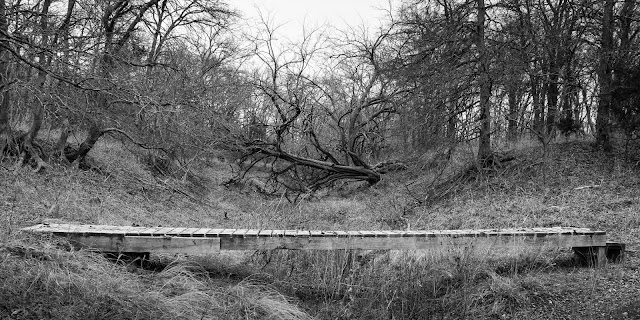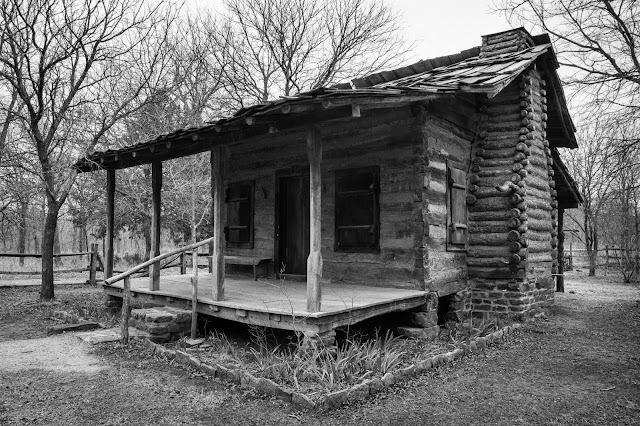The Bittern Marsh Trail was my planned destination, hoping to see some waterfowl. The nice lady at the gate said conditions were pretty dry, but I figured it was still worth checking out.
In warmer weather, I doubt this is something I'd want to take the time to shoot.
I don't know my Texas birds very well yet, so I have no idea what this little fellow is. Some outreach is definitely in order.
Edit: Jim Jones, Education Chair with the Fort Worth Audubon Society, came through quickly with an ID.
Your photo is a Carolina Wren. The reddish breast and the 'white speckles' dotted along the edge of it's wings are key markings.
This one I know -- a female Northern Cardinal ...
... and a male on the run. I'm looking forward to getting a MUCH better cardinal photo at some point. They were by far the bird I saw the most.
The marsh was indeed a bit dry. I still saw cardinals, herons and plovers from the two blinds, though. I'll bet there's a lot more activity when things are wetter and warmer.
Interesting pattern on the head of this dead marsh plant. The bend in the stalk is striking, too.
There was plenty of evidence that this area does get quite a bit wetter in the form of numerous boardwalks.
Not sure about these two, either. There were about a dozen of them in the river. Willet? Long-billed Curlew?
Edit: Jim to the rescue again!
The wading birds are Greater Yellowlegs. There are two species of
yellowlegs: Greater and Lesser. Greater Yellowlegs are more common in
north Texas in January while the Lesser Yellowlegs range further south.
But remember that all migrating species range overlap, some birds lag
behind due to illness or just got separated from their flock/family and
it decided to foloow the other species, etc.
Characteristics are very hard to see at quick glance, and some are only easy when the two are standing side by side.
Your
photo shows two characteristics that make this ID easy. In winter, the
Greater's bill takes on a 2-tone coloring as the base of the bill
lightens while the tip remains black. (the lesser's bill is black
overall). The other characteristic to distinguish is a bit harder unless
the bird shows you a close-up profile shot (which your photo does.) The
length of the Greater Yellowleg's bill is roughly 1.5 times the length
of it's head, while the Lesser Yellowleg's bill is about equal to the
length of it's head. The greater's bill also has a very slight up-turned
bill while the lesser's bill is straight. Two other characteristics to
observe: when foraging, the greater is more frantic moving quickly back
and forth, while the lesser will be more sedate (pausing more often and
looking around.) The other characteristic to observe is the greater's
body will appear to be more bulky while the lesser is slimmer.
After the 2.1 miles on the Bittern Marsh Trail, I gave the Cottonwood Trail a shot. The advertised highlight is the Minor-Porter Log House, which dates back to the 1870s. After moving some benches that didn't date back quite that far, I was able to compose a shot that felt like a fairly authentic period shot to me.
I say the house was the advertised highlight, because I ran into something later on the trail that ended up making my day. An armadillo!










No comments:
Post a Comment